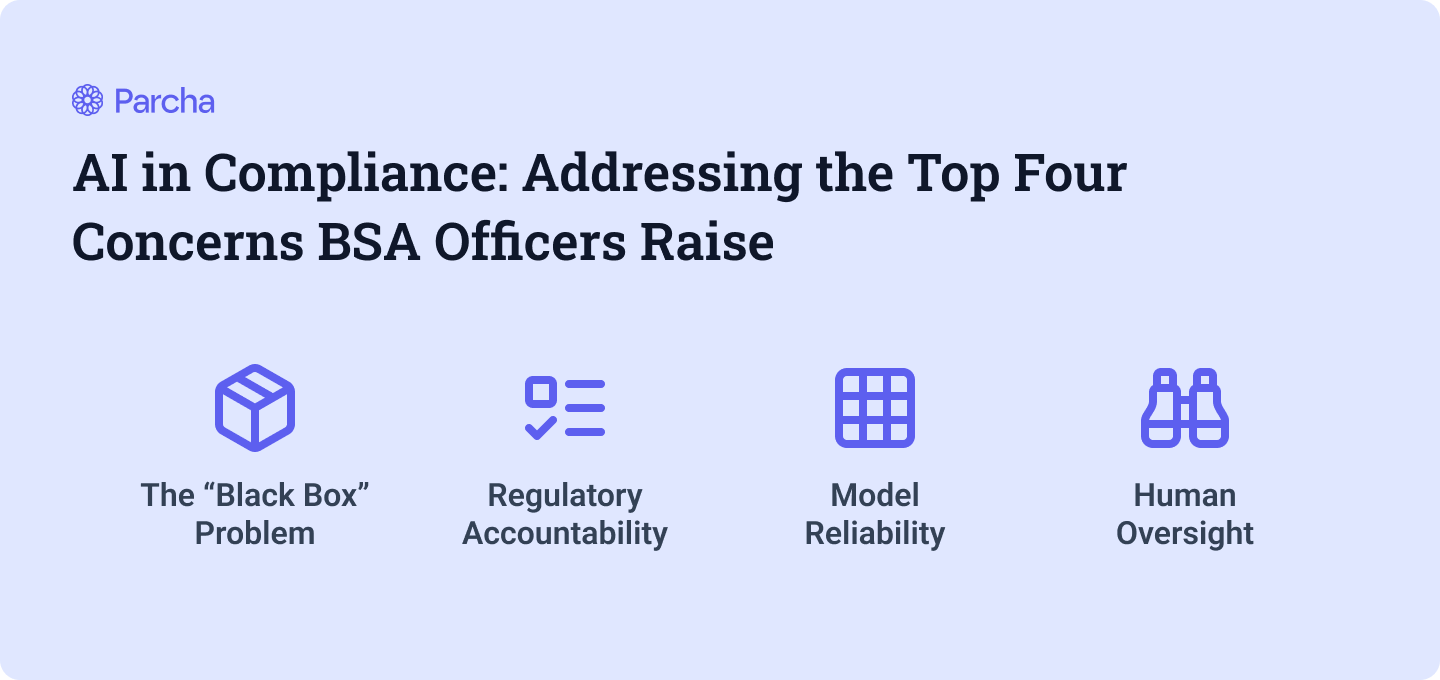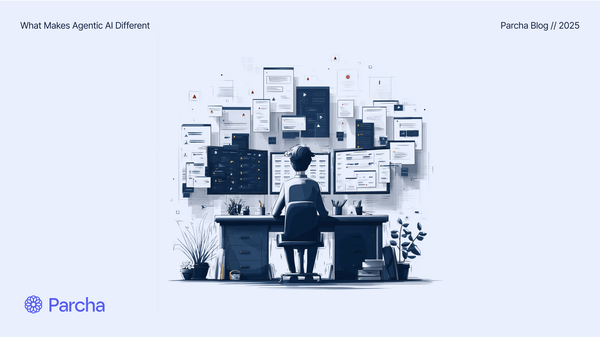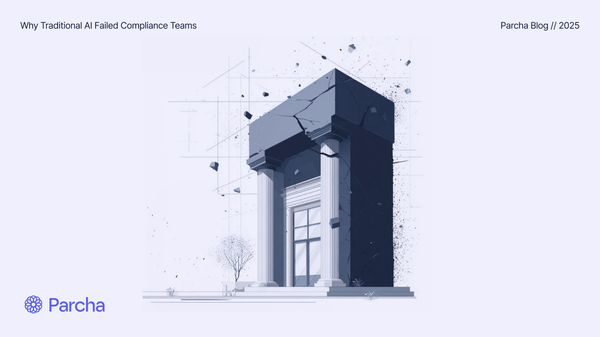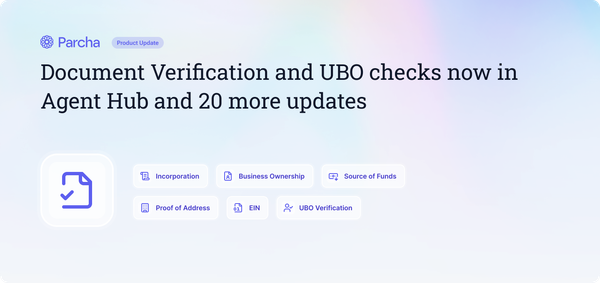AI in Compliance: Addressing the Top Four Concerns BSA Officers Raise
For BSA officers tasked with balancing speed, accuracy, and regulatory defensibility, the right AI system does not replace human oversight. It reinforces it with transparency and accountability, built from the ground up with compliance in mind.

In financial institutions, AI has the potential to transform compliance processes. It can significantly reduce false positives, speed up due diligence, and allow human analysts to concentrate on complex, high-risk, and high-value tasks.
But for many BSA officers, that potential is shadowed by serious concerns.
How do you trust a system you can’t explain? What happens when regulators come knocking? How do you ensure your institution’s judgment isn’t outsourced to an algorithm trained on biased data?
These are the real and pressing issues that compliance leaders raise in conversations with technology vendors every day.
At Parcha, we’ve heard them all. And helped our customers navigate each one with practical strategies that don’t just satisfy regulators, but actively improve the quality and speed of compliance outcomes. A key part of that success lies in Parcha’s use of Agentic AI, which doesn’t just generate insights, but takes intelligent action within clearly defined guardrails.
This article will address the top four concerns BSA officers consistently raise when evaluating AI-powered compliance systems:
- The “Black Box” Problem
- Regulatory accountability
- Model reliability
- Human oversight
And we will share how leading fintechs and banks are successfully harnessing AI - not as a black box, but as a powerful, transparent, and auditable ally.
The Four Most Common BSA Objections to AI
1. The “Black Box” Problem

For most BSA officers, trust in an AI system begins with one core question: Can you show me how it works?
Generative AI (or even traditional machine learning models) often come up short. They're opaque by nature, making predictions or decisions without offering clear visibility into how a conclusion was reached. This lack of explainability is what’s commonly referred to as the “black box” problem. And in the context of AML compliance, it’s more than a technical hurdle. It’s a regulatory red flag.
In financial compliance, every decision needs to be justified with clear logic, auditable records, and defensible reasoning. From why a customer was flagged to why a transaction was escalated while another wasn’t. If your team can't explain why a suspicious activity alert was (or wasn’t) triggered, you're opening the door to regulatory scrutiny and reputational risk.
Thankfully, not all AI is a black box. Parcha’s Agentic AI is purpose-built for transparency. Every decision the system makes – whether it’s rejecting a high-risk applicant or escalating a flagged transaction – is backed by a detailed audit trail. Compliance leaders can trace:
- What data was used to inform the decision
- What checks were applied (from sanctions screening to document verification)
- How thresholds and policies were interpreted
- And why the final outcome was chosen
This level of traceability is what makes Agentic AI viable in a regulatory environment.
The takeaway for BSA officers? AI can be 100% explainable, but only if it’s built with compliance in mind from the ground up. Anything less is just another black box waiting to break.
2. Regulatory Accountability
Financial institutions are subject to strict regulatory expectations that govern how compliance programs are designed, implemented, and audited. That includes clear rules around data protection, auditability, and pre-implementation oversight for any technology touching AML decision-making.

So when AI enters the conversation, one of the first questions BSA officers ask is: Will this system stand up to regulatory scrutiny?
The concern is valid. Many AI systems on the market today lack the transparency and governance controls needed to meet evolving regulatory standards. You’re taking a significant risk if your institution:
- Can’t show how a system made a decision
- Can’t prove that it did so in compliance with your internal policies and external obligations
The consequences can range from reputational damage to substantial fines.
Take the case of Evolve Bank & Trust, which was hit with a Federal Reserve cease-and-desist order in June 2024 for deficiencies in anti-money laundering, risk management, and consumer compliance programs related to its fintech partnerships. The bank, which was a primary partner of the now-collapsed middleware provider Synapse Financial, failed to maintain effective risk management frameworks and controls for its Banking-as-a-Service operations (1). The system wasn't inherently flawed because it used automation or partnered with fintechs. It failed because it wasn't purpose-built for regulatory compliance in the complex web of fintech relationships.
The lesson is clear: Without auditability, automation creates regulatory exposure.
That’s why Parcha was designed from the ground up to meet the unique demands of financial crime compliance. Every decision made by Parcha’s Agentic AI is:
- Traceable through detailed audit logs,
- Aligned with institution-specific risk thresholds, and
- Documented to support regulatory exams or internal reviews.
Parcha also enables banks and fintechs to engage with regulators early. All documentation and decision logic is approved by compliance personnel before an agent is deployed.
This pre-implementation transparency helps institutions build trust with their supervisory bodies and avoid surprises during audits.
3. Model Reliability
Even the most transparent and auditable AI systems are only as good as the data they’re built on. If your AI is trained on poor-quality, outdated, or biased data, it wouldn’t matter how fast or traceable the system is. It won’t be reliable.
And in the world of financial compliance, unreliable models don’t just cause headaches. They create risk.

BSA officers know this all too well. A system that generates excessive false positives buries analysts under a mountain of noise, wasting time and resources on benign activity. Even worse, a system prone to false negatives may allow high-risk customers or transactions to slip through undetected, leaving the institution exposed to regulatory action and reputational damage.
Parcha’s Agentic AI addresses this by prioritizing both data integrity and system robustness at every stage. In minutes, the platform runs over a dozen checks per case, including sanctions, adverse media, and PEP screening; business research; address verification; document validation, and much more.
This multi-layered approach significantly reduces the risk of overlooking critical red flags or misidentifying legitimate customers.
What sets Parcha apart is that these checks aren’t static. The system continuously learns and adapts, refining decision thresholds based on institution-specific policies, feedback from human reviewers, and emerging risk patterns.
4. Human Oversight
If there’s one thread that runs through every BSA officer’s hesitation around AI, it’s this: What happens when automation overrides human judgment?

In financial compliance, experience matters. So does context. A seasoned compliance officer can spot nuance in a customer profile or transaction pattern, that a machine might miss:
- A subtle inconsistency
- A geographic risk
- A gut instinct based on years of handling edge cases
The concern isn’t that AI will be inaccurate. It might be decisive when it shouldn’t be.
If a system escalates the wrong alert (or worse, fails to escalate a real one) the consequences go beyond operational inefficiency. They can include reputational damage, regulatory censure, or even legal action. Compliance leaders know that when something goes wrong, “the AI did it” isn’t a defensible position. Responsibility still rests with the institution.
That’s why the most successful implementations of AI in compliance don’t aim to replace humans but to empower them.
Parcha’s approach is firmly grounded in this philosophy. Its Agentic AI brings speed and scale to high-volume, time-consuming, low-complexity tasks like:
- Sanctions screening
- Adverse Media/Negative News screening
- PEP screening
- Document checks
- Business Due Diligence
But when it comes to nuanced or high-risk decisions, the human stays in the loop.
Every decision made by the system is logged, traceable, and reviewable. Analysts can drill into the reasoning, challenge an outcome, or override a decision based on their expertise. This hybrid model protects institutional judgment while still delivering the speed and consistency that automation offers.
A good way to think about this is autopilot versus copilot. Traditional compliance automation acts like autopilot—you set it and forget it, trusting the system to navigate without your input. But compliance requires navigating complex regulatory terrain where context matters, where edge cases emerge, and where the stakes of getting it wrong are severe. What you need is a copilot, an AI that handles the routine tasks with precision while keeping you informed, engaged, and ultimately in control of critical decisions. The copilot doesn't just execute; it explains its reasoning, flags uncertainties, and defers to your expertise when situations demand human judgment.
For BSA officers, this is the key takeaway: AI in compliance should never be about surrendering control. It should be about scaling your capacity, not sidelining your judgement. Any platform that removes your ability to review, override, or audit decisions is simply a compliance disaster waiting to happen.
Conclusion: Evolving Compliance with Confidence
For BSA officers tasked with balancing speed, accuracy, and regulatory defensibility, the right AI system does not replace human oversight. It reinforces it with transparency and accountability, built from the ground up with compliance in mind.
Parcha’s Agentic AI was purpose-built to meet the needs of modern compliance leaders, with features designed to support:
- Explainability
- Auditability
- Reliability
- Human-in-the-loop design
Institutions like FV Bank, Airwallex, Pipe and IG are proving that AI can drive faster, smarter, and safer outcomes, without sacrificing control or compliance.
Here are three steps compliance operations teams can take when collaborating with BSA officers to implement AI in compliance programs:
- Ensure auditability: Maintain detailed audit trails that clearly document how each compliance decision is made, including data sources and decision logic.
- Engage regulators early: Proactively schedule meetings with your primary regulator to review AI implementation plans before deployment.
- Start small, build trust: Begin with lower-risk use cases and expand gradually as systems prove reliable and governance frameworks mature.
So, are you ready to evolve your compliance program?
Click here to learn how Agentic AI can help you move faster, stay compliant, and make better decisions.
(1) Fed hits Synapse partner Evolve Bank with cease-and-desist order - American Banker, June 14, 2024, https://www.americanbanker.com/news/fed-hits-synapse-partner-evolve-bank-with-cease-and-desist-order**





